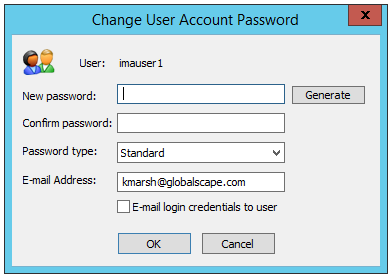Changing a User’s Password
You can change users' passwords from within the administration interface. When a new password is created, EFT determines whether the password meets complexity and reuse requirements.
-
The change password function supports user principal and common names (AD/LDAP). That is, it supports UPN (e.g., jdoe@globalscape.com; looks like an e-mail address) and CN (e.g., jdoe).
-
For high security-enabled Sites, you cannot manually create a password; the only option is to click Generate to create a unique, complex password.
-
If enabled, users can change their passwords in the Web Transfer Client, and the account management web page.
- On AD/LDAP Sites, if you have enabled the "User must change password at next logon" feature in AD, you must enable (set to "on") the registry setting described in KB article 10516. If you have enabled the "User cannot change password" feature in AD, users will not be able to change their passwords.
To change a user's password
-
In the administration interface, connect to EFT and click the Server tab.
-
On the Server tab, click the user you want to configure.
-
In the right pane, click the General tab.
-
Click Change Password. The Change User Account Password dialog box appears.

-
Do one of the following:
-
In the New password and Confirm password boxes, type and confirm the password. (Not available for high security-enabled Sites.)
-
Click Generate. A complex password is generated and entered in the New password and Confirm password boxes.
-
-
Click the Password type list to specify a type from the following:
-
Standard - A plain text password is required.
-
Anonymous - Any password, including nothing, allows an anonymous connection.
PCI DSS requirements state that you should not use group, shared, or generic accounts and passwords. To address this requirement, EFT hides the Anonymous password type for high security-enabled Sites anywhere that the password type is selectable, or if Enforce Strong Passwords is enabled.
-
-
To email the user's password, type the e-mail address and select the E-mail login credentials check box. If the e-mail address is configured in the User Details, the E-Mail Address box is completed automatically. If you type an invalid e-mail address, an error message appears. (SMTP must be configured on EFT to e-mail the user.)
-
Click OK. The Change User Account Password dialog box closes and the e-mail is sent, if configured.
-
Click Apply to save the changes on EFT.